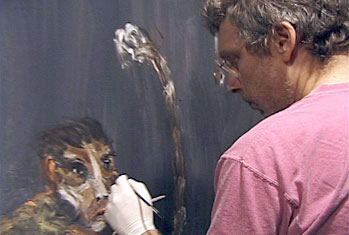Michael Hafftka’s work is in The Metropolitan Museum, Museum of Modern Art, Brooklyn Museum, San Francisco Museum of Modern Art, Carnegie Museum, NY Public Library and the National Gallery.
I was born in 1953 on Riverside Drive in Manhattan. Shortly after I was four, my family moved to the Marble Hill section of the Bronx. My father, Simon Hafftka, and mother, Eva Hershko, were refugees from Europe and survivors of the Holocaust. My father and his cousin Alexander Hafftka were the only survivors of a large family whose great uncle was Dr. Waldemar Mordecai Haffkine (the scientist who developed the vaccine for Cholera). Much of my understanding of the world came from my perception of my parents’ wartime experiences. A strong desire for freedom was among the host of determining factors and experiences that later brought to bear on my becoming an artist.
My mother died in 1971 and I went to Budapest (on the earnings I made working in a bike shop and as a sales clerk in an Army & Navy store) to meet my maternal grandmother whom I had just discovered was still alive. My grandmother didn’t speak modern English; she spoke to me in the English she learned from reading Shakespeare. It was a funny and poetic experience. On the way back from Budapest, I went to Barcelona and lived like a hobo for several months. I was moved by all the art and architecture I saw. The buildings of Gaudi especially struck me.

I feared going to Vietnam. I had been turned down as a Conscientious Objector, but being number 13 in the draft lottery, I was sure I would be drafted. Luckily the draft ended the year I could be called. After travelling to Germany, Hungary and Spain I came back to the United States. In New York, I often went to the Museum of Modern Art and the Metropolitan Museum of Art. I made money peddling jewelry in front of Bloomingdale’s and peddling my own photographs in front of the Met and MOMA. I had also been working in a camera shop.
In 1972, I went back to Barcelona for six months. In Barcelona, I wrote poetry and observed a foreign land with a childish freedom that came from not knowing the native language. When I returned to New York, I continued to peddle. In 1973, when the Yom Kippur War broke out, I decided to volunteer to work on a Kibbutz in Israel. To get the fare, I sold my camera to pay for half of the fare. The Jewish Agency of the State of Israel  paid for the other half after I agreed to work for at least one year. In the center of the kibbutz was a water tower. It was the tallest structure in the area. I made a studio in a room under the water tank. After a year I moved to Hertzelia where I lived in a shack in the middle of an orchard just a short walk away from the Mediterranean Sea. I would arise in the morning, pluck the fruit from a tree, swim and paint day and night. I decided to move back to New York where I could pursue a career as an artist.
paid for the other half after I agreed to work for at least one year. In the center of the kibbutz was a water tower. It was the tallest structure in the area. I made a studio in a room under the water tank. After a year I moved to Hertzelia where I lived in a shack in the middle of an orchard just a short walk away from the Mediterranean Sea. I would arise in the morning, pluck the fruit from a tree, swim and paint day and night. I decided to move back to New York where I could pursue a career as an artist.
To read Michael’s full bio please click here
Heart On watercolor, crayon & ink on paper 22 inches x 30 inches 2014

